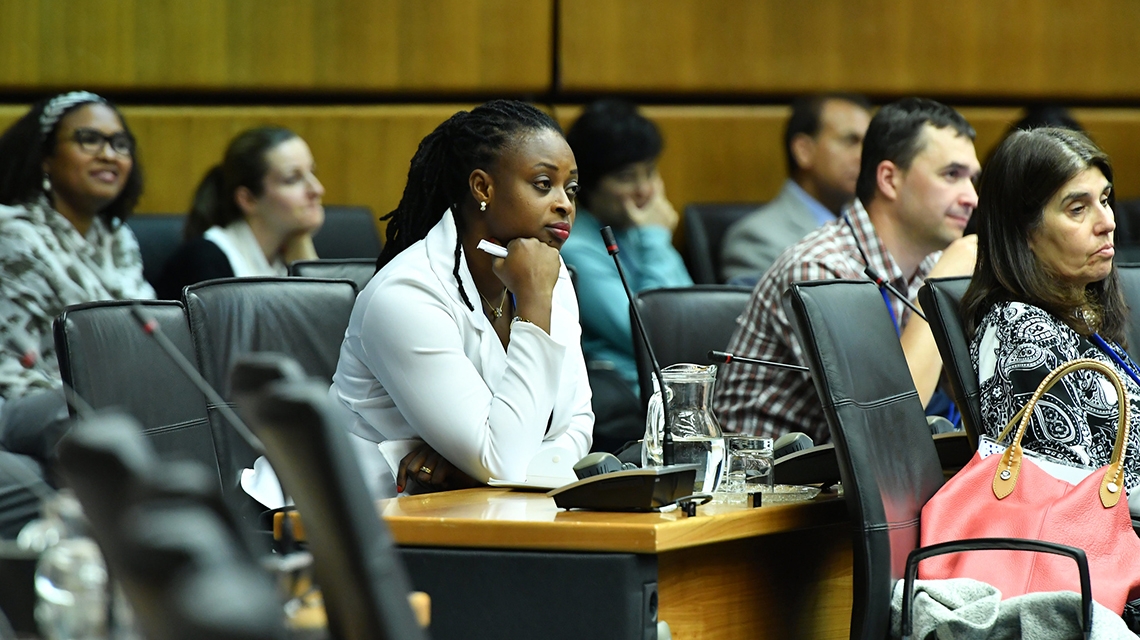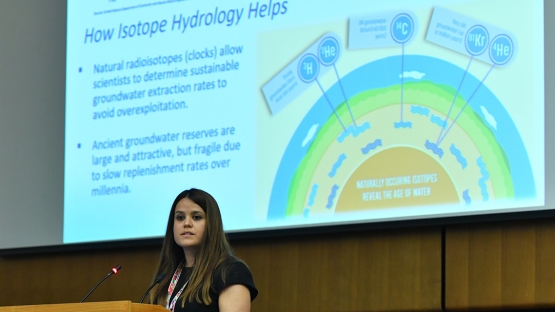IAEA Wraps Up International Symposium on Isotope Hydrology
The IAEA International Symposium on Isotope Hydrology closed in Vienna today. (Photo: D. Calma/IAEA)
Lasers, atom traps, krypton. These exciting, isotope hydrology
techniques were discussed, together with the importance of big data,
during the IAEA’s International Symposium on Isotope Hydrology
that took place in Vienna this week. Almost 250 international experts
from 78 countries exchanged ideas and knowledge on this wide-reaching
application of nuclear technology.
“This IAEA Isotope Hydrology Symposium is a testament to the important role nuclear techniques have played in improving water management for almost 60 years,” said Melissa Denecke, Director of the IAEA’s Division of Physical and Chemical Sciences.
“This IAEA Isotope Hydrology Symposium is a testament to the important role nuclear techniques have played in improving water management for almost 60 years,” said Melissa Denecke, Director of the IAEA’s Division of Physical and Chemical Sciences.
Overall, the global trajectory for sustainable and clean water looks rather bleak in many regions, and yet we have also seen positive signs that are a testament to taking serious action on water issues.Many of the papers presented this week revolved around themes of water supply, replenishment and sustainability, or the impacts of pollution or scarcity, and in all cases the use of nuclear techniques added an important and informative dimension that could not be attained with traditional hydrologic approaches, Denecke said.
Understanding water problems
At the
Symposium, experts shared examples of how countries, cities and regions
are facing varying degrees of water stress, ranging from
overexploitation of aquifers and surface waters, to drought and water
shortages, to systemic and widespread surface and groundwater
pollution.
Although United Nations Sustainable Development Goal 6 includes access to safe water for everyone by 2030, statistics from the Global Water Institute suggest that 700 million people worldwide could be displaced by intense water scarcity as soon as 2030. This is so because, globally, water supplies are being stretched beyond sustainable limits to meet the growing demands from population growth and intensive agriculture.
“Overall, the global trajectory for sustainable and clean water looks rather bleak in many regions, and yet we have also seen positive signs that are a testament to taking serious action on water issues,” Denecke said. She gave the example of the changing attitudes on conserving water in Cape Town, South Africa, after their water crisis, or the long-term reversal of serious nitrate contamination of shallow aquifers in the Netherlands. “These, in the global context, are but small costly steps in the right direction,” she said.
To read more about the work of the IAEA in Isotope Hydrology, read our latest Bulletin on Water.
Although United Nations Sustainable Development Goal 6 includes access to safe water for everyone by 2030, statistics from the Global Water Institute suggest that 700 million people worldwide could be displaced by intense water scarcity as soon as 2030. This is so because, globally, water supplies are being stretched beyond sustainable limits to meet the growing demands from population growth and intensive agriculture.
“Overall, the global trajectory for sustainable and clean water looks rather bleak in many regions, and yet we have also seen positive signs that are a testament to taking serious action on water issues,” Denecke said. She gave the example of the changing attitudes on conserving water in Cape Town, South Africa, after their water crisis, or the long-term reversal of serious nitrate contamination of shallow aquifers in the Netherlands. “These, in the global context, are but small costly steps in the right direction,” she said.
To read more about the work of the IAEA in Isotope Hydrology, read our latest Bulletin on Water.

Emerging techniques
At the Symposium,
water experts looked at new isotope techniques that could help address
widespread pollution problems. These include new analytical methods for
nitrogen, phosphorus and boron isotopes to address nutrient pollution
issues by fertilizers, manure and other sources.
Scientists talked about emerging isotope techniques with lasers and atom trap analysis to increasingly use long lived non-reactive argon and krypton noble gas isotopes to assess replenishment over hundreds to million-year timescales.
“Being here and hearing what state-of-the-art tools we can use and what challenges some scientists have is useful for spurring new ideas,” said Tricia Stadnyk, Associate Professor of water resources engineering at the University of Manitoba in Canada and keynote speaker at the Symposium. “It’s useful for scientists to know what data can do and to see the greater picture: the application of their results.”
They also discussed the importance of big data — from remote sensing vigilance like GRACE satellite data, to the IAEA’s Global Network of Isotopes in Precipitation (GNIP) — which allow for new, more advanced isotope-enabled water balance models to help scientists predict how global rain water distribution and aquifer replenishment rates will change over time due to land use, agriculture and climate change. Radioisotopes such as tritium and helium were part of the discussion too, since these can increasingly help map areas of the world’s landscapes and watersheds to ensure the effective protection of the most vulnerable aquifers from contamination.
An outreach event called “Water, Water Everywhere? Helping IAEA Member States with Water Resources and Water Security” took place on the sidelines of the Symposium. IAEA experts discussed the various ways nuclear science and technology can help advance water management, from improving water availability, optimizing efficiency of water use, treating wastewater in an environment-friendly way to monitoring marine pollution.
Scientists talked about emerging isotope techniques with lasers and atom trap analysis to increasingly use long lived non-reactive argon and krypton noble gas isotopes to assess replenishment over hundreds to million-year timescales.
“Being here and hearing what state-of-the-art tools we can use and what challenges some scientists have is useful for spurring new ideas,” said Tricia Stadnyk, Associate Professor of water resources engineering at the University of Manitoba in Canada and keynote speaker at the Symposium. “It’s useful for scientists to know what data can do and to see the greater picture: the application of their results.”
They also discussed the importance of big data — from remote sensing vigilance like GRACE satellite data, to the IAEA’s Global Network of Isotopes in Precipitation (GNIP) — which allow for new, more advanced isotope-enabled water balance models to help scientists predict how global rain water distribution and aquifer replenishment rates will change over time due to land use, agriculture and climate change. Radioisotopes such as tritium and helium were part of the discussion too, since these can increasingly help map areas of the world’s landscapes and watersheds to ensure the effective protection of the most vulnerable aquifers from contamination.
An outreach event called “Water, Water Everywhere? Helping IAEA Member States with Water Resources and Water Security” took place on the sidelines of the Symposium. IAEA experts discussed the various ways nuclear science and technology can help advance water management, from improving water availability, optimizing efficiency of water use, treating wastewater in an environment-friendly way to monitoring marine pollution.


No comments:
Post a Comment